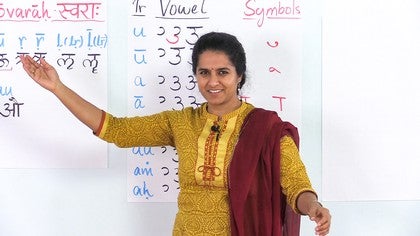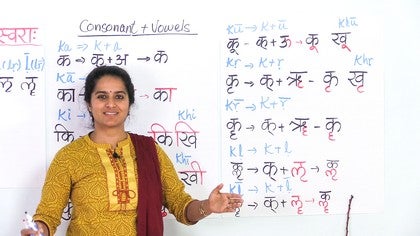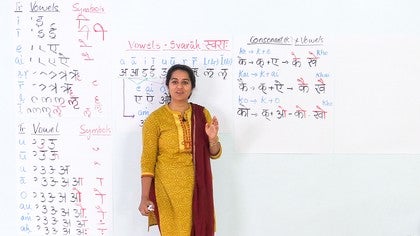Description
About This Video
Transcript
Read Full Transcript
Namaste dear friends, Swagatam welcome again to another session on the Sanskrit alphabet. We have thus far seen what this alphabet sounds like and then we also explored a little bit what these alphabets look like. The Sanskrit language is often written in the Devanagari script. You see because we have these different letters they can be represented in different scripts. You can have the sound a written in the English a like that or you can use another script like the one we have here. This is the Devanagari script. Deva means gods Nagari of the land of. So this is the script that is of the land of those gods. You would wonder why or how a script can be of the land of gods. It's a mystery and yet there is a certain science behind this. When you hear a certain sound that particular vibration can also correspond to a certain image. So when you take the picture of that sound they say that it corresponds to this image. So there is a direct correspondence between the sounds we are making and what they're creating at a visual level. So that is quite amazing and they say that that is also the feature of sacred languages. Hebrew being another one of them that I know of. With Sanskrit they also call it the language of the gods. It's the Deva Bhasha. Deva gods Bhasha language. The reason why Sanskrit is known as the language of the gods is again not because of some mythical quality of this language. The beauty of the language is that it seems to have a quality of creation which is a characteristic of the gods. So when you make a sound you create a certain experience and therefore in Sanskrit every sound is conscious of the experience that it creates in the universe. With words as well all the words can be drawn back or derived from root sounds that correspond to the very experience of that word. Now how good can it get? I'll just give you a small example and then we'll move on to the letters. You have the English word peace. Now in English the word peace of course is generally popularized with the sense of peace or shanti but we also have P-I-E-C-E which is a piece of cake. So the sound peace has been given a certain meaning but it doesn't correspond to the inner experience of feeling calm. Well in Sanskrit we have the word shanti which comes from the root sham and they say that if you keep saying sham sham it will generate a sense of peace. So when you sound a letter and you write the letter they say that it has the same meditative quality about it. So let's dive deep into the written aspect of this language and see how it touches us. Just as the sound touches us in a certain way, become observant as what happens to you when you try to write these letters out. We'll start with the vowels also known as the swara because they stand alone. They don't really need an element of touch to make the sound come out. An example again you have the aa and you can go on for eternity like that but with the consonants there's a slight difference. A consonant we'll look at it known as Vyanjana has an element of touch so to get the sound k there has to be a component of the vowel and then you get the k but we'll discover this as we go on. Just stay with me. So we saw that there are five places of pronunciation in the vocal system. We have the throat, the guttural, the palatal, the cerebras which corresponds to the center of the roof of your mouth, the dentals just lightly behind your teeth and the labials or corresponding to your lips. Each of these vowels also corresponds to these different places of touch so aa short and long vowel the long being twice the measure of the shot and that's what gives it the music of the word. So let's look at the corresponding places of pronunciation with the vowels. We have at the throat so you have aa, ee, ee, oo, they are the most common primary vowels that you hear. Then we have another one which is that it's a little harder but just try and place your tongue there and you'll get it then we have the that's when you place your tongue behind your teeth very lightly in the transliteration you have the L with a dot but I have also seen it represented as an L R with a dot below it so if you see both variations I guess they both right and you can choose and then you have the a which is a combination of R and E put together and then I when you go from aa to oo you get the o and then you have the aa these are also known linguistically as the diphthongs they are in between sounds and then we have the um and ah um is known as the Anuswara and is the dot that represents this nasal sound and we have the two dots beside which represent the aspirate sound and that is the ah or the visarga the two dots there now that we have sounded it again and we have a general idea of what it looks like let's try to learn how to write it but as you see it's not a very straightforward simple thing I'll show you how we can write this step by step with the strokes but I will change the order a little bit now a small game for you try and see if you can find patterns in these letters are the symbols that look similar and you will notice that we have the letters oo the letters ah ah oh oh and um and aha they have this number three in common so let's try and change the order of the letters a little bit but try and develop it from this idea of what is their basic and how it adds on so I will divide this piece of paper into three parts we have the transliteration here which I will just represent with the TR and then I will put the vowel with the strokes and then the last part of it is the symbol when these vowels combine with the different consonants they become symbols you will not see them written in these entire forms when the vowels stand alone or they come as an independent phoneme or single sounds within the word they would look like this but when it combines with a consonant each of these vowels becomes a separate symbol so I will also indicate to you on this side what the symbol looks like and try and show you how it can be derived out of the shape of the letter itself follow me and I hope it'll get clearer as we move so that part will be the symbols we'll start with the letter u the vowel u is like the three you've heard of the band u2 in Sanskrit we have the u3 and remember that it might help I'll just be dropping these tips here and there if it helps you well and good if it doesn't just feel free to find your own system whatever works is very good so we have the u the first stroke is like that the second one is u and you would go on with the three but I will write it using another color and just putting it all together that is the u you will notice that I'm using a line on top all these letters have a line on top of them this what we call Shiro Rekha or headline is almost a way of defining these individual words okay so when you have one letter you just put that line to cover both aspects of the letter so the symbol of the u looks like that looks like a small round and a tail yeah there the next sound that we have is the u it starts more or less in the same way so then you make it into the three and then you add an extra tail there that's the and the symbol of the sound is the you have to stretch your imagination a little bit but Sanskrit is all about flexibility so play with it discover these discover your own mechanism the next letter is the so we are building it gradually one two with a bridge and bridge and this stick you will recognize the stick in the consonants specially but this is the letter the first letter from the throat the and because it's the first letter it's the vowel that goes along with all the other letters the consonants and therefore it gives the consonants that independent existence so interestingly enough there is no separate symbol to represent the sound the vowel doesn't have any symbol because it is the way the consonant is represented independently a consonant is a combination of plus a and when you see it written down it will be the car incorporating the vowel inside it we'll come to it don't worry just that there is no extra symbol for this and then we have the vowel the long one and this is how it gets written ah two three four and there it is so these extra red markers are what will help you remember the symbol of that letter so that's the ah I also normally recommend that as you write these letters keep sounding them keep sounding them so in your brain there are many connections that happen the way the mind or the brain works is that when you have a certain information the more networks you can make with that piece of information the better it sticks in your system so as you are writing it out and sounding it and seeing it you're adding various networks to that one information of the sound or all of them the next letter that is in the same group as these letters we have been seeing is the oh and it is written you go all the way up to there so you go two three four and now we are coming to it so you have the ah and you add the oh which is just an extra like the ah but it has a single antenna on the head that comes all the way to the head here that's it yeah okay and then the symbol of that is oh like that right we'll then write the next sound which is the ow and is very similar except it has a double antenna so we have the ow which is the one two three four five and then it is represented by the and double antenna there so the symbol of the ow is a stick with two antennas on the head we then have the next letter which is in this group which is the um as you see the transliterated form it's a combination of a plus the mm and the mm is represented by the dot that we saw here there that one so we go all the way again so we can do this faster now two three four five and it is the dot on top there so that is the um and then we have the final one in this group which is the ah and this is how it is written you will definitely get the uh once you go through these different steps so it is the one two three four and put the line there and you put the two dots by the side so it's represented by the two dots with the ah so you have it here ah would you like to try saying that with me once so ooh remember u3 not the u2 band the next number who has the extra tail ah is the tail almost turning into a stick ah is the oh with an extra stick by the side extra T then oh is the ah with the T and the antenna on the head oh is the T with a double antenna on the head um is just a dot on top of the head and ah is the two dots by the side now what I also recommend that we do because I tried playing with these sounds and what I found very helpful is to bring in a dimension of the body with these sounds because the entire Sanskrit alphabet is also known as the matrika it is a measuring out coming from the root ma so it measures out the universe in terms of vibrations they represent different specific vibrations and so as you were writing it there was a certain flow of energy as you sounded it there was a certain flow of energy I think it's just a fun exercise to try and also involve the body so what you could try and do is just feel fully relaxed and then play with it so try and dance with this so imagine yourself writing it ooh put the line on the head this can be very relaxing believe me you can write it with the left hand play with it play with it dance with these sounds dance with these sounds and these sounds will get embedded in you and at night you might even dream of these sounds so we have these different letters in the series that we have seen here we will move on to the next set of letters we have now the EE and AI which are remaining so let's try and represent that I'll keep the same pattern so we have the transliteration we have the vowels and we have the symbols okay so there we go we look at the vowel EE the vowel EE is funny you can almost associated with an image it's like when you see a snake you go and that's what it looks like a bit it's like a snake with a tail okay so it's start with the stick then you do goes all the way and there's a tail e that's the shot e and the symbol is a little different it is a stick that comes before the consonant and there is a hook on the head like that e the next one is the long ball is the EE and it starts in the same manner the good thing is that they always the long vowel is always a development of the shot so you have EE so that's the EE and then you have the there's the snake on the head it's like the hood so that's the way you can remember that there is a snake with a hood on the head and that's the long e that's the scary one and this is when the letter comes after I'll just do that again for you that is how you would see it written when we write it sometimes the the hook can go on this side or that side but usually you would see it written like that okay with the hook on the side so the direction is the same that's it next we have the a so the a is a little in this series you have one two three and you can put the line there that's fine okay so one two three four lovely and it is represented by the symbol of a single antenna on the head of the letter itself so that's an a the next one is the I is the same as the a but there is a double antenna so we have one two three four five and its symbol is the I I the remaining vowels are the and so we'll see how it's written I have written it as the cursive are but just for clarity I will write it as the regular are there you see that's the print are so this is represented as one two three four five one two three four and four and this one can be written like that so that is the symbol of the letter it comes below the letter the following one is the the longer one and it is written like that one two three okay since we have already written it you just have to add a double C below it and that is the below the letter we have the last two which are the and the I write it like this the L with the dot below for now it is the one two and as you complete that you just add this below it and then this and that and this is often represented as itself when you write it under the letter so this gets written as a small the entire letter it would have been good to write this entire letter the entire letter gets written below the consonant that it attaches itself to and the final one is the long one and it is the step one two three and the final version is one two three four there you go and that is what the letter looks like you just have to add another below it so that is the symbol of that letter so we have the letters ooh looks like that oh and this side we have II II and I won't worry too much about trying to get the symbols in this particular session this session was really focused on trying to get the vowels the independent vowels right in the next session we will look at how each of these vowels combines with the consonants in this particular picture you just have an idea of it in the next one we will explore them in detail and in order so I hope to see you with me again in the next session namaste and danya vada ha danya vada ha danya vada has a deeper sense going to the root of the word dhanam means wealth danya means wealthy vada is speech so when you tell danya vada to someone then the other person has been made more wealthy by what you have given is one way of understanding it but then as a giver you become more rich when you give somebody something so danya vada is a sense of feeling wealthy you feel wealthier and the person you are giving to is also wealthier so thank you danya vada
Mother Tongue: Writing the Vowels
Comments
You need to be a subscriber to post a comment.
Please Log In or Create an Account to start your free trial.











